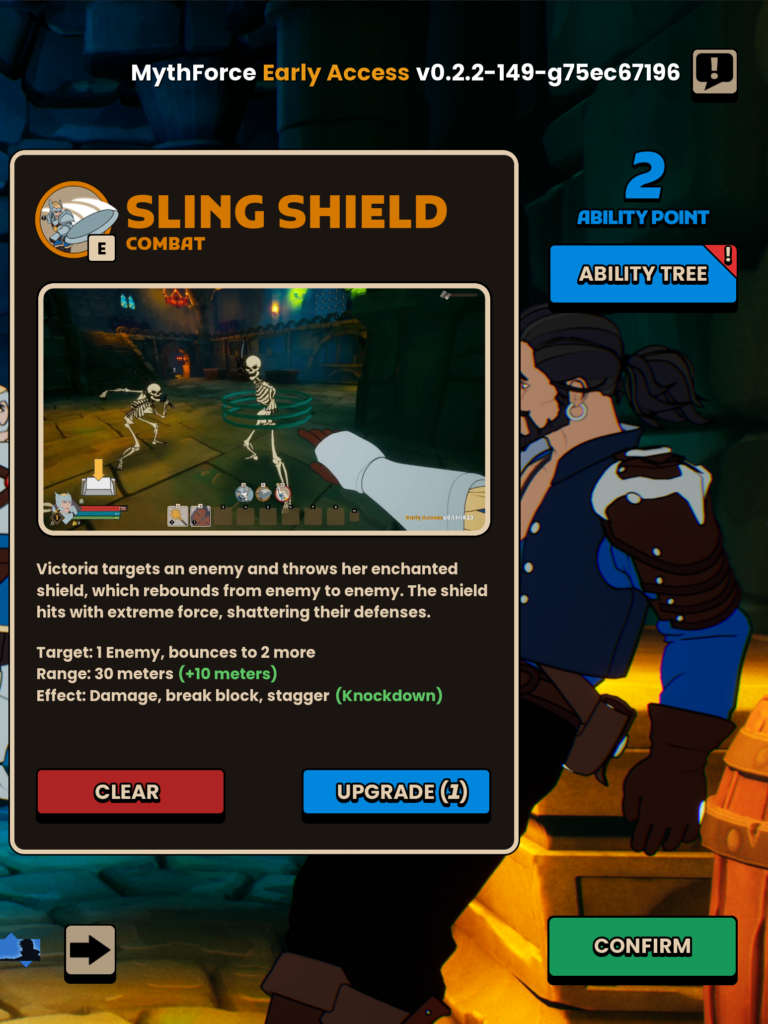Narrative treatment for Game Characters
Project: MythForce
Engine: Unreal Editor 4
Character: Hawkins, the Ultimate Archer
My role in creating Hawkins was to lead the team of three who prototyped, implemented, animated, and added visual polish to his abilities including a transparent shader. I worked with the audio designer to trigger all the sound effects via our gameplay Blueprints, too.
Character Development
I supervised production of three new abilities* for Hawkins after a two week concept phase. As we iterated on these character abilities, and his per session leveling attributes, they became the initial driver for Hawkins’ narrative characterization. My responsibilities included naming and describing each of the abilities (and their upgrades) in the context of existing MythForce lore.

*Abilities were authored with Gameplay Ability System, an add-on in Unreal Editor for Combat systems implementation
My mission was to add nuance to this character using gameplay verbs displayed in first person perspective. A post linked below discusses verbs.
I’ll start the discussion on narrative by noting the most impactful decision I made.
While reviewing Hawkins’ ability prototypes I chose to cut his Overcharge ability, Volley of Souls, which summoned a hail of arrows. Rift Arrow—a crowd control ability invoked via a bouncing bomb arrow—would eventually replace it for launch. This teamplay-focused ability was designed and implemented during a two month period. Its inspiration came from the zombie-attractant properties of pipe bombs from Left 4 Dead.
The pivot to Rift Arrow required additional work both for implementation and creating a clear visual language for his two arrow abilities. Lower budget alternatives included moving forward with a new ability building from existing Volley of Souls hand gesture animations. These would have applied new gameplay effects instead of damage over time: an area of effect debuff ability or a global speed boost for allies. Condensing our timeline to deliver Rift Arrow was a risk worth taking because it allowed us to add multidimensionality to his character while preserving the core gameplay vision.
Previously all visions for the fourth party member leaned towards grenade abilities. Hawkins had been written as an Alchemist Demolitions expert, and as a Cleric who threw Holy Hand Grenades.
However, leadership shifted direction on his defining qualities as we started. This major shift came with a new core gameplay vision for him to become the Ultimate Archer. The Cleric concept had recently been realigned to make him a Vampire Hunter. Now leadership was pushing for him to be a generic survivalist, the Beast Hunter, to provide narrative justification for the archery skillset that our direction required.
His backstory was becoming muddled; until we achieved a clear gameplay design to guide it. I led project-wide design group brainstorms and discussions about teamplay archetypes, with the main goal of enhancing party dynamics. These meetings transitioned his identity towards a mercenary with deep spiritual connections.
Not only is Hawkins the Ultimate Archer, but also a summoner who interacts with the spirit realms. His Overcharge Ability slices open rifts that have a tangible impact on the physical world.
Our team adapted his ability theming to iterations in his backstory, though we still fought to keep promising gameplay from existing prototypes. When his wrist-mounted spike launchers disappeared from concept art, it challenged our implemented Combat ability designs. So we negotiated to give him a bracer that summons a ghostly bow from the spirit realms instead. His Spirit Bow then shoots an arrow straight ahead, ignoring all collisions with the level. This ability became Phantom Shot. Gameplay-driven iterations on his abilities were eventually integrated into the backstory and dialogue. Also, the storyboards to guide iteration on ability visuals became part of the core vision for his narrative treatment.
Writers consulted with our team to ensure our gameplay intentions guided their dialogue rewrites. Traces of older concepts that described Hawkins as a Alchemist Grenadier or Vampire Hunter were adjusted or culled from from the localization database with my editing support. We worked together to use verbs for consistent narrative treatment.
Read more about his abilities and the underlying intentions for characterization and gameplay in this post
Narrative Design tasks for the Ability Loadout Screen
I wrote and scripted systems to show dynamic text for all of Hawkins’ abilities, as well as for the other three characters.

Victoria’s Combat ability: Sling Shield
This is one of twelve character abilities that required rewrites and dynamic text. Only one of two upgrades is selected at a time or the base ability. Upgrades include green text to identify additional properties or the deltas when the white text has been altered from 20 to 30 meters in this example.
The main issues I corrected from the previous writing passes were
- Parts of descriptive paragraphs were overly specific to the base ability or did not match new gameplay for any one of our upgrades
- Created a system of variables that tied to gameplay tuning, allowing all numerical changes to be automatically adjusted
- Applied variables into Append nodes on blueprint, creating strings with appropriate spacing and formatting to deliver the intended result in all cases


